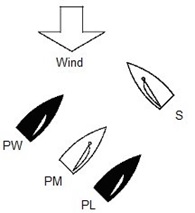



CASE 125
Definitions, Obstruction
Definitions, Room
Rule 19.2(b), Room to Pass an Obstruction: Giving Room at an Obstruction
Rule 43.1(b), Exoneration
Rule 43.1(c), Exoneration
When an outside overlapped boat is required to give room to
one or more inside boats to pass an obstruction, the space
she gives must be sufficient to permit all the inside boats to
comply with their obligations under the rules of Part 2.

Facts
Boats PW, PM and PL were close-hauled and overlapped on port tack. Boat
S was close-hauled on starboard tack. PW was on a collision course with S.
PM and PL did not need to change course to pass safely astern of S. PW
bore away to pass astern of S without making contact, and PM bore away to
give her just enough space to do so. PL held her course and there was contact
between PM and PL, without damage or injury. No boat took a penalty. PM
protested PL.
Question
How do the rules apply to this incident and which boat or boats should be
disqualified?
Answer
S was an obstruction to PW, PM and PL because each of them would need
to change course substantially if she were sailing directly towards S and
were one hull length from S, and because they all were required by rule 10
to keep clear of S (see definition Obstruction). PL had the right under rule
19.2(a) to choose to pass S on either side because she had right of way over
both PM and PW. However, PL was not entitled to hail for room to tack
under rule 20 because she did not need to change course to avoid S (see rule
20.1(a)). As PL passed astern of S, rule 19.2(b) required PL to give room to
both PM and PW between her and S. Rule 19.2(b) also required PM to give
PW room.
The space that PL was required to give to PM and PW included enough
space for PM to give PW room and for PM to keep clear of PL, as well as
space for PW to keep clear of both S and PM (see the definition Room). PL
did not give that space. Therefore, she broke rule 19.2(b), and should be
disqualified. PL also broke rule 14 because the contact could have been
avoided if PL had given PM and PW enough space. However, because PL
had right of way over PM and there was no damage or injury, PL was
exonerated by rule 43.1(c) for her breach of rule 14.
PM broke rule 11, but she was exonerated by rule 43.1(b). PM did not break
rule 14 because it was not possible for her to have avoided making contact,
either with PL or with PW. (See Case 11 r discussion of a similar situation.)
World Sailing 2013






